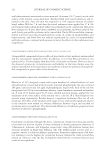J. Cosmet. Sci., 72, 163–171 (March/April 2021) 163 Effectiveness of the Disinfection of Reusable Make-Up Applicators—Initial Experiences P IOTR ZALĘCKI, JOANNA TWARDOWSKA, DANUTA NOWICKA, and WALDEMAR ANDRZEJEWSKI, Fa culty of Physiotherapy, University School of Physical Education, Wroclaw 51-612, Poland (P. Z., J.T., W.A., D.N.), Department of Dermatology, Venereology and Allergology, Wroclaw Medical University, Wroclaw 50-368, Poland (D.N.) Accep ted for publication December 15, 2020. Synop s is Make- up accessories may be subjected to bacterial contamination due to their contact with many surfaces, including the client’s skin. Disinfection prevents the spread of infection, but the capacity to eliminate microorganisms varies among disinfection methods. Little is known about disinfection in beauty salons therefore, we aimed to compare the effectiveness of disinfectants for reusable make-up applicators. We tested reusable make-up applicators (natural brush, synthetic brush, and sponge) with disinfectants (bactericidal soap, 70% ethanol, and Hydro Sept solution). The number of microorganisms present before and after disinfection using the plate method was assessed. In comparison to water, bactericidal soap reduced the number of bacterial colonies. There were 418 versus 83 colonies in natural brush samples, 1,162 versus nine colonies in synthetic brush samples, and 617 versus three colonies in sponge samples. Ethanol eliminated 100% of bacterial growth. Disinfection was more effective on applicators used for dry products (natural brush) than for wet products (sponge, synthetic brush). We conclude that disinfection is a complex process and depends on the type of make-up applicator being disinfected and the type of cosmetics being used. Further research on the selection of appropriate disinfection procedures for individual applicants and for those who prepare makeup is needed. INTRO D UCTION Reusa ble make-up applicators come into contact with many surfaces, including in par- ticular the client’s skin, which contributes to their contamination with various microbes (1). In the case of cosmetics, microorganisms such as Candida albicans, Pseudomonas aeru- ginosa, Serratia marcescens, Escherichia coli, Burkholderia cepacia, Klebsiella oxytoca, Staphylococ- cus aureus, and Enterobacter gergoviae pose the greatest risk and negatively affect the health of consumers (2). Data from the literature indicate that products and make-up accessories may be subjected to bacterial contamination, depending on the number of people using the cosmetic, the composition of the cosmetic, and the users’ hygiene habits. Wilson et al. Address all correspondence to Danuta Nowicka at danuta.nowicka@umed.wroc.pl
JOURNAL OF COSMETIC SCIENCE 164 (3) draw attention to the possibility of bacterial contamination of cosmetic tools and products in the case of when they are used by a person with a bacterial infection. Disi nfection, i.e., the deliberate use of chemical and physical factors to reduce the num- ber of biological pathogenic microorganisms, contributes to the elimination of vegetative forms of microorganisms. However, the spores of these microorganisms are normally resistant to chemical disinfectants. Appropriate disinfection of surfaces and tools in a beauty salon prevents the spread of infection from one client to another. The correct selection of disinfectant plays an important role in the disinfection process, as different disinfectants have different effi ciencies. There are many reports in the literature regarding disinfection in medicine and dentistry, but there are no reports on this subject in the fi eld of cosmetology (4). This research was conducted to increase knowledge of the processes of choosing effective disinfection methods in a beauty salon. The aim of the study was to compare the effective- ness of three different preparations for disinfecting reusable make-up applicators with regard to their duration of action to inhibit microbial growth. MATER IALS AND METHODS The f ollowing reusable make-up applicators were subjected to the research: the natural make-up brush M Brush by Maxineczka No. 07 (Maxineczka, Lódź, Poland), the syn- thetic make-up brush Zoeva No. 104 (ZOEVA GmbH, Frankfurt am Main, Germany), and also the Beauty Blender make-up sponge (Rea.deeming Beauty, Inc., Bethlehem, PA). Before starting the tests, all the applicators were used for applying face makeup. The e ffectiveness of the agents was assessed based on the change in the number of micro- organisms present before and after disinfection. The analysis of the number of microor- ganisms present was performed using the plate method. DISIN FECTANTS Commo nly used disinfectants were used to disinfect the applicators: 1. Pr otex Ultra bactericidal soap from Colgate-Palmolive (New York, NY), 2. 70 % medical spirit (ethanol) from Alpinus Chemia (Solec Kujawski, Poland), batch number: 1178D120718, series No.: 1179A160718, 3. Hy dro Sept solution for disinfecting surfaces and tools from Silcare Company (Gorzów Wlkp., Poland), permission to trade biocidal product No.: 2072/05, series No.: 08/2019. LABOR ATORY MATERIAL The f ollowing were used in the tests: 1. Si x sterile ready-to-use Sabouraud-Gentamicin Chloramphenicol two agar from BioMerieux Co. (Marcy l'Etoile, France) containing agar on Petri dishes with a diameter of 90 mm (Solution Basin, 55 mL, from Heathrow Scientifi c, Vernon Hills, IL) 2. On e sterile plastic pipette, 3. Th ree sterile plastic bacteriological tubules from Thermo-Scientifi c (Waltham, MA), 4. On e 250-mL glass beaker, 5. Si ngle-use gloves,
Purchased for the exclusive use of nofirst nolast (unknown) From: SCC Media Library & Resource Center (library.scconline.org)

























































































































